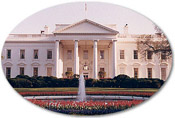

MILLARD FILLMORE
Biography
On July 9, 1850, President Zachary Taylor died in office. The next day Vice President Millard Fillmore was sworn in as the 13th President of the United States. He was the second Vice President to assume the Presidency after the death of a President in office.
Fillmore has been considered one of the lesser U.S. presidents. Yet he was a statesman whose support for the Compromise of 1850 helped to prevent civil war and preserve the Union for ten years. He was also a diplomat whose dispatch of a U.S. expedition to Japan helped open that nation to world trade.
He Enters Politics
As a young lawyer Fillmore became active in local politics. In 1828 he won election to the New York legislature. In 1832 he was elected to the U.S. House of Representatives.
Fillmore began his career in Congress at a time when the question of slavery was being hotly debated. Those who hated slavery hoped that it might at least be banished from the nation's capital. But Southern representatives were able to “gag” (prevent) discussion of this issue. Fillmore attracted attention when he presented a petition to abolish slavery in the District of Columbia (Washington, D.C.). He supported former president John Quincy Adams in the battle for free speech and the right of petition. Adams later recalled that Fillmore was “one of the ablest, most faithful men” with whom he served in public life.
In Congress, Fillmore generally followed the lead of the Whigs and of Henry Clay of Kentucky. The Whig Party had been formed in the 1830's and represented a combination of various groups opposed to President Andrew Jackson.
After serving four terms in Congress, Fillmore decided not to run again in 1842. In 1844 he tried but failed to win the Whig nomination for vice president. He also ran for governor of New York but was defeated.
Vice President
At the 1848 Whig National Convention, General Zachary Taylor, a popular Mexican War hero, was nominated for the presidency. Taylor lived in Louisiana and owned slaves. Abbott Lawrence, a wealthy cotton manufacturer from Boston, was proposed for the vice presidency. But the antislavery Whigs refused to “have cotton at both ends of the ticket.” In order to satisfy this group, Fillmore was nominated for vice president. In the election of 1848, Taylor and Fillmore defeated the Democratic candidates, Lewis Cass and William O. Butler.
The election came at a crucial time. The United States had just defeated Mexico in the Mexican War and acquired an enormous amount of territory, including present-day California. The question was whether slavery should be allowed to expand into this new territory. With 15 free and 15 slave states in the Union, the admission of California would upset the balance in the U.S. Senate.
There were other serious disputes. Southerners demanded the return of fugitive (runaway) slaves. Northerners demanded the ending of the slave trade in Washington, D.C. Some people predicted the breakup of the Union because of the controversy. Alarmed at the increasing hostility, Henry Clay introduced a number of resolutions in the Senate as a compromise between North and South.
President
While the debate on the compromise raged, President Taylor died suddenly. There was no question where the new president stood on the issue. In his first annual message to Congress in December, 1850, Fillmore urged acceptance of the compromise as the best means of restoring pace to the nation and maintaining the Union.
The Compromise of 1850 was the outstanding domestic achievement of Fillmore's administration. Under its terms, California joined the Union as a free state. The other territories won from Mexico were organized without restriction on slavery. The slave trade was ended in the District of Columbia. But a stronger law for the return of fugitive slaves was to be enforced.
With California in the Union, the United States took greater interest in the Far East, especially Japan. For more than two centuries, Japan had been virtually closed to the Western world. Only one port, Nagasaki, was open to foreigners.
In late 1852, Fillmore authorized a special naval expedition to Japan to deliver a letter to its emperor suggesting closer relations with the United States. A U.S. squadron under Commodore Matthew C. Perry arrived in what is now Tokyo Bay in 1853. Perry delivered Fillmore's letter to the emperor's representatives in a golden casket. The Treaty of Kanagawa, signed in 1854, a year after Fillmore had left the presidency, opened two Japanese ports to U.S. commerce. Additional treaties were later signed with the United States and other Western nations.
Fillmore failed to win nomination by his party for the presidency in 1852. By accepting the Compromise of 1850 and strictly enforcing the Fugitive Slave Law, he lost the support of the Northern antislavery Whigs. Only the Southern Whigs supported him. General Winfield Scott won the nomination but lost the 1852 election to Democrat Franklin Pierce. Fillmore thus became the last Whig president.
Retirement and Remarriage
After leaving the White House in 1853, Fillmore returned to his law practice in Buffalo. Abigail Fillmore died that same year. In 1858, Fillmore married Mrs. Caroline Carmichael McIntosh, a widow.
In the election of 1856, Fillmore ran for president as a candidate of the American, or Know-Nothing, Party. But he carried only Maryland. Democrat James Buchanan won the election. When the Civil War broke out in 1861, Fillmore was a loyal supporter of the Union, although he was critical of President Abraham Lincoln's policies.
In Buffalo, Fillmore was active in civic affairs. He was a founder of the General Hospital, the first president of the historical society (where his letters are now kept), and chancellor of the University of Buffalo. He died in Buffalo on March 8, 1874.








